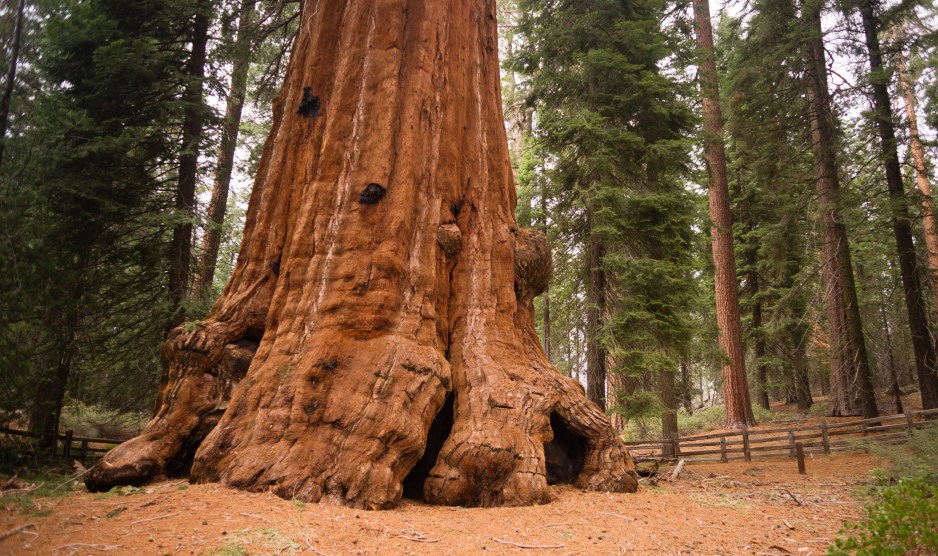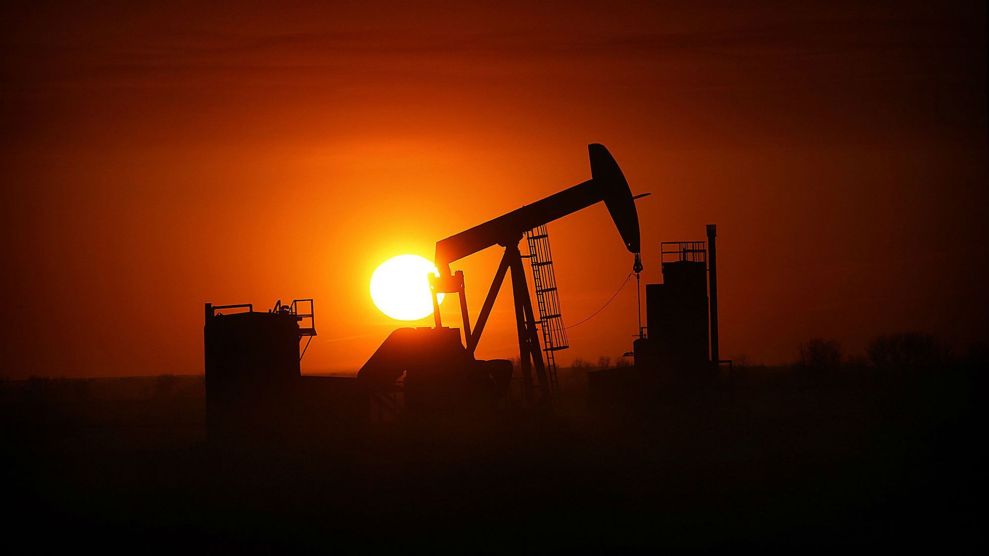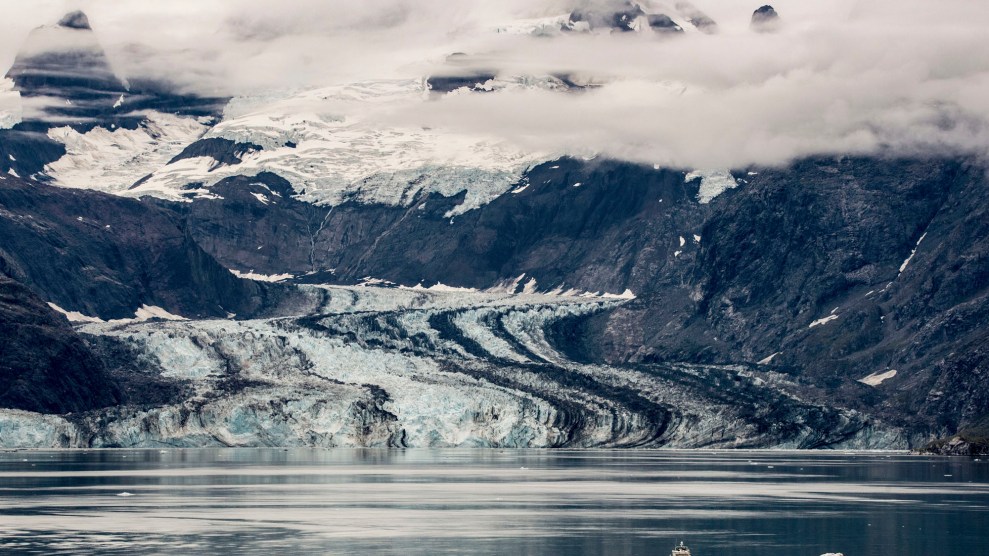
ChrisBoswell/Getty
This story was originally published by The Guardian and appears here as part of the Climate Desk collaboration.
For the largest living things standing on the planet, California’s giant sequoias have an unassuming, almost gentle aura to them. The recognizable cinnamon-colored bark is soft and fibrous. Its cones are modest. When cut down, the trees tend to shatter and won’t produce reliably sturdy timber.
These majestic plants have a lineage stretching back to the Jurassic period, but fears over their future have prompted a somewhat counterintuitive plan presented to the Trump administration— in order to save the giant sequoias, some say, their surrounding area must be stripped of protected status.
As part of the Trump administration’s determination to roll back regulation and open public land to private industry, the interior secretary, Ryan Zinke, is currently undertaking a review of more than two dozen national monuments declared since the 1990s. The stated goal of the review is to reboot extractive industries such as mining and logging. Supporters of the Giant Sequoia monument fear a unique ecosystem is at risk from timber industry advocates who would peel back protections.
“If this were a different administration and there was a push by the timber industry and its allies to shrink the monument, I wouldn’t take it too seriously,” said Chad Hanson, a rangy tree ecologist who has agitated for greater sequoia protections for the past two decades. “But the Trump administration? Oh, yeah. We are taking this threat very seriously.”
At a boisterous public meeting in June, the Tulare County supervisors voted 3-2 in support of a plan to shrink the Giant Sequoia national monument, which contains the majority of the world’s population of the towering trees, to less than a third its current size. The decision sparked bellowing acrimony that required the county sheriff to step in to restore calm. “It kind of got out of control,” said Steve Worthley, vice-chairman of the board of supervisors in Tulare County, California.
Worthley, an attorney and former corporate counsel for Sequoia Forest Industries, argues that the government isn’t doing enough. “We have had a passive system and it ain’t working—we are losing giant sequoia groves because we aren’t taking care of the land,” said Worthley. “If we’re going to have groves in the future, we have to get back to active management.”
In a letter to Zinke, the supervisors decry a “tree mortality epidemic” fueled by lengthy drought and raging wildfires. The solution, the county members suggest, is to reduce the size of the monument area so that loggers can remove trees that may combust and threaten the stands of sequoias.
A 328,000-acre connected protected area on the slopes of the southern Sierra Nevada would be transformed into small pockets of no-logging zones covering just the sequoia clusters themselves—a plan that some scientists warn would degrade the wider ecosystem and, ultimately, the sequoias.
Giant sequoias, the bulkier cousins of the coastal redwoods found along California’s coast, only grow in scattered sites along a 260-mile stretch of the Sierra Nevada’s western face. A precise cocktail of moisture, elevation and temperature help provide the trees’ heft. General Sherman, the most famous giant sequoia of all, is 275ft tall and 36ft in diameter at the base. Some trees are even taller, taking 2,000 years and longer to push more than 300ft towards the heavens.
The Sierra Nevada range boasts three national parks—Yosemite, Sequoia national park and Kings Canyon national park—but it wasn’t until the creation of the Giant Sequoia national monument in April 2000 that the majority of giant sequoia groves were placed under formal federal protection.
Bill Clinton used his authority under the antiquities act to carve out the protected area, which is split in two zones adjacent to Sequoia national park. The 33 giant sequoia groves are mixed among ponderosa pine, white fir, incense cedar, dozens of animal species and a clutch of chalet-like houses with pitched roofs arranged alongside narrow, twisting roads. The monument is dotted with grandiose granite domes, limestone caverns and archaeological sites that have been shaped by glaciers, volcanic activity and early inhabitants.
Clinton’s predecessor, George HW Bush, visited the area to declare a more informal ban on logging in the sequoia groves only in 1992. The tree the president stood next to when signing the proclamation was subsequently dubbed the “Bush bush” and residents of this largely conservative outpost were left with the impression the region’s timber industry would be left largely unmolested. Then the monument came.
Kent Duysen’s family has run sawmills in Tulare County since the 1960s. The creation of the national monument may have been hailed by conservationists but it also resulted in the rapid closure of Duysen’s largest mill in the summer of 2000, putting 105 people out of work.
“It was the hardest thing I’ve ever had to do, work-wise,” he said. “There wasn’t enough timber to keep it running. It was a land grab by Clinton.”
Duysen, who now operates just one sawmill near the town of Terra Bella, said he’s “sick of the out-and-out lies” of environmentalists who he said falsely claim he wants to cut down the sequoias.
“I’ve heard it for years,” he said. “We don’t want to cut them. But the forest needs to be thinned out. The opponents of the reduction in the monument aren’t locals, they are from Los Angeles or San Fransisco or from out of state. I would say 90% of the people here support the change in the size.”
Tulare County is a “home-rule sort of county set within a liberal state,” according to Gary Adest, a biologist who moved to the area 30 years ago and now runs a 772-acre ranch with his wife, Barbara, near the small town of Springville.
“Donald Trump seems to have a hatred of everything Barack Obama did,” said Adest, who cuts a striking figure with his pointy beard and explosive Hawaiian shirts. “Well, local people here feel the same about Bill Clinton—a liberal guy in Washington telling you how you’re going to run your backyard.”
Tulare County, which is roughly twice the size of Delaware, reaches from the southern Sierra Nevada across a vast slab of the flat farmland of the San Joaquin valley. An 1884 map of the county, which hangs in the supervisors’ building, extols the “Italian sky” and fertile soils that provide a “treasury of wealth to the general farmer”.
Yet unemployment is notably high here and the county has one of the worst poverty rates in California. Trump won 53% of the county’s vote in last year’s election. Tourism is a bright spot—the county pulled in about $380 million last year from visitors who flock to see the sequoias—that could be blighted by a shrunken monument. “Let me put it this way,” said Eric Coyne, deputy Tulare County administrator, in May. “Somebody from Ohio is probably helping to pay for your police and fire.”
Worthley insists the monument must be cut down to around 90,000 acres to help stem a number of huge fires he believes put the sequoias at risk. A buildup of vegetation in the untouched monument, he contends, is providing the kindling for fires sparked by lightening, faulty power lines or accidents. And while the US Forest Service, which manages the monument, has the authority to remove dead trees and reduce fuel load through controlled fires, Worthley said in practice the agency had done “virtually nothing.”
“There is so much fuel that when a fire gets going it’s like a nuclear bomb,” he said. “We have lost great sequoias. They can handle a bit of heat but they are still living things and the heat is so intense, the tree just fries.”
Hanson is scathing about this stance, pointing to numerous studies that show how fire has actually been suppressed in many protected areas—to the detriment of giant sequoias. Worthley, Hanson said, is “completely ignorant and knows nothing about tree ecology.”
Giant sequoias have evolved for millions of years alongside fire. They drop serotinous cones that open up in the heat, with the half-inch seeds found inside germinating best in the ashy remnants of a recent forest fire. The trees are also extremely hard to kill off with fire—a thick hide of bark protects the living tissue within. Flames can gouge holes in the trees, creating cave-like “cat faces” that can house hibernating bears, but this doesn’t usually doom the tree.
Hanson also quibbles with the idea that logging removes fire fuel. The timber industry, after all, wants to remove sizable trees—which aren’t the things that spread fire. The debris left behind, the scraps of bark and branches, along with bushes, provide a more effective kindling for flames.
“If you curb fire even more, that will harm the sequoias,” Hanson said. “We have been loving them to death, in a way. They depend on fire to help release seeds and reproduce.
“Opening up the monument to more logging won’t reduce fire intensity, it will just damage the habitat. We need to let more fires burn in remote areas, and suppress them near people and property. Let fire be fire out in the forest.”
Culling trees outside the sequoia groves also puts at risk a broader web of biodiversity. The black backed woodpecker, for example, relies upon fire-damaged trees to create its nests. The cavities the birds leave behind provide a home for a host of animals that can’t do this beak-breaking work themselves, such as bluebirds and wrens, as well as flying squirrels, martens and chipmunks.
A fire that tore through 29,000 acres of the southern Sierra Nevada last August has resulted in a “beautiful, spectacular regeneration” for wildlife, according to Hanson.
“The giant sequoia ecosystem isn’t just the sequoia groves,” he said. “They are the centerpiece but there is a broader landscape that includes rare species that have huge home ranges. If you only have protections for the groves, the ecosystem would start to unravel and fall apart.”
Hanson said this process would ultimately harm the giant sequoias, either through the lack of reproductive fire or the loss of groundwater through the stripping away of trees that knit together the landscape. “Eventually the risk is that you’d have older trees dying and not being replaced,” he added.
The local brawl over the Giant Sequoia national monument predates the Trump presidency but it has striking similarities to how the national conversation has stalled on important issues. Science is deployed to counteract nostalgia, and vice versa. The two sides talk past each other. The common ground of agreed-upon facts shrinks and then calcifies.
For those who hope to retain the monument in its current form, the best hope is not that the administration will be swayed by evidence but that it simply will be distracted by even more contentious protected lands elsewhere.
“There is an attitude here about a way of life, that ‘My daddy did this, I’m doing this and my sons and daughters should do this’, ad infinitum,” said Adest, the biologist, who still is considered a newcomer, 30 years on.
“But in Washington DC, I don’t think this monument shows up on the radar. I don’t think they know the issues here. So I don’t think it will change. But who knows.”















